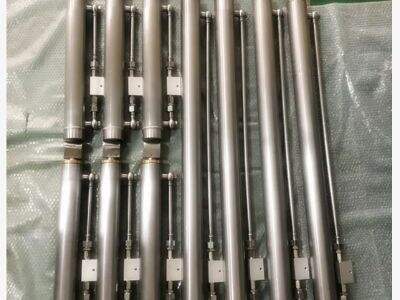Steps to Follow to Create a Hydraulic Cylinder: Materials and Tools First you will need metal tubes, plates and rod. You’re also gonna need a welding machine, a welding helmet, gloves, and safety glasses. This tools and materials, will help to create a strong hydraulic cylinder.
Materials and tools needed to weld a hydraulic cylinder
Metal tubes, plates, and rods
Welding machine
Welding helmet
Gloves
Safety glasses
With your materials and tools now gathered, you are ready to cut the metal and prep it for welding. Here’s how to do it well:
Cutting and Prepping the Metal for Welding: A Step-by-Step Guide
Measure and cut the metal pipes, plates, and rods as per your hydraulic cylinder design.
Cut the metal pieces to the proper lengths with a metal saw.
Grind metal as needed to remove any burrs.
To ensure that the welding will perform efficiently, use a wire brush to clean the metal surfaces.
Now that we have the metal pieces cut up and ready to go, we can start assembling and welding the hydraulic cylinder power pack together.
Here are some tips to ensure your weld is strong:
– Technologies for assembling and welding of the hydraulic cylinder
Arrange the metal components properly to form the hydraulic telescoping cylinder.
Clamps to Keep the Metal Pieces Tight During Welding.
Use a qualified welding method (MIG or TIG welding) to bond the parts of the metal.
Be sure not to weld cracks or weaknesses.
Once everything is welded together check the hydralic cylinder for leaks or any weak spots. Take the following steps to ensure it is functioning properly:
Checking for leaks or weak points in thet welding work:
Hydraulic fluid should be added to the hydraulic cylinder.
Do not exceed the rated test pressure.
Look for any fluid leaking out of the welded joints to check for any leaks.
Test the hydraulic cylinder for no drop in pressure on a pressure gauge.
Follow these guidelines to ensure the final hydraulic cylinder performs effectively and remains durable.
Here are some of the tips you should consider for the hydraulic cylinder to function properly and last a long time.
Periodically inspect the welded hydraulic cylinder joints for cracks or weak spots.
Hydraulic cylinder keeps lubricated to eliminate friction, which causes wear.
Do not exceed the hydraulic cylinder to its capacity limits.
Examine entire Hydraulic Cylinders for any leakage or broken parts, and take corrective action immediately to avoid further damage.

 EN
EN
 AR
AR
 BG
BG
 HR
HR
 CS
CS
 DA
DA
 NL
NL
 FI
FI
 FR
FR
 DE
DE
 EL
EL
 HI
HI
 IT
IT
 JA
JA
 KO
KO
 NO
NO
 PL
PL
 PT
PT
 RO
RO
 RU
RU
 ES
ES
 SV
SV
 CA
CA
 TL
TL
 IW
IW
 ID
ID
 LV
LV
 LT
LT
 SR
SR
 SK
SK
 UK
UK
 VI
VI
 HU
HU
 TH
TH
 TR
TR
 FA
FA
 MS
MS
 GA
GA
 CY
CY
 KA
KA



